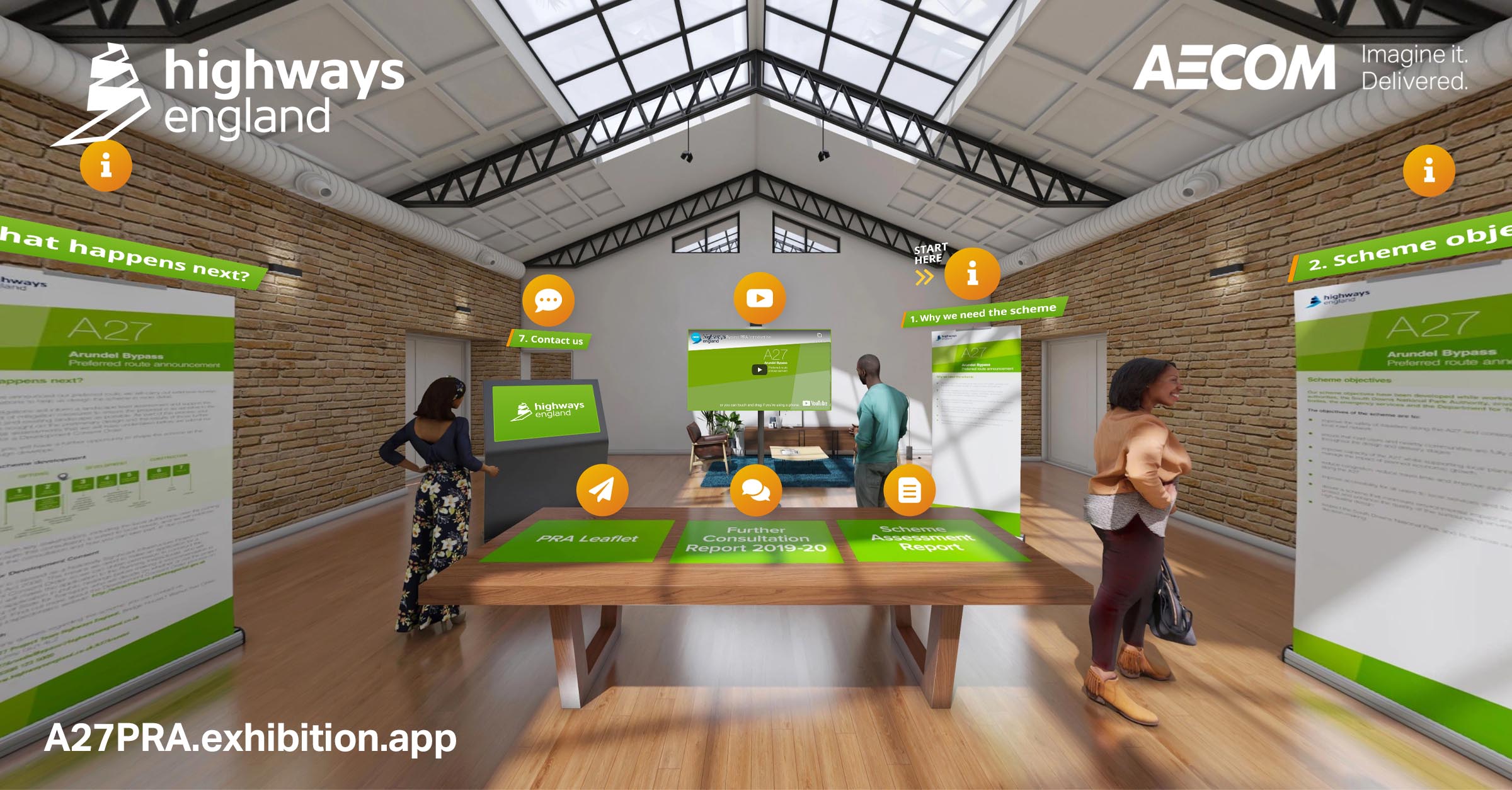Digital engagement can help infrastructure be more equitable
The Future of Infrastructure
One impact of the lack of diversity in the infrastructure industry is an under-appreciation of the social, racial and gender dynamics of the populations we are building for. To address this potential blind spot, it's essential to consult with the people who will use the infrastructure. AECOM's David Innis argues that new digital approaches can help reach demographics who have historically been left out of the conversation.
Infrastructure has the power to shape societies, but the industry faces challenges when it comes to diversity. In London, which prides itself on being one of the most diverse cities on earth, Mayor Sadiq Khan is taking steps to encourage the industry to become more representative of the people it serves, following a report. It shows that the Black Asian and minority ethnic (BAME) community accounts for 43 percent of London's population, but only 6 percent of the infrastructure industry, compared to 15 percent for all sectors. The report also highlights a poor record on employing women: 21 percent compared to 47 percent for other sectors.
This lack of diversity can be found across the industry globally. Statistics compiled by the U.S. Bureau of Labor show that the construction industry workforce is 88.1 percent white, and only 10.3 percent female. In the largest infrastructure companies worldwide, only 8 percent of top managers and board members are racial minorities in the country in which they work.
The failure to represent the full range of experience and thought within society risks perpetuating inequity by missing the viewpoints of significant parts of the population. To ensure that we deliver on the requirements for modernized infrastructure, consultation with a representative sample of the community is essential.
Ensuring infrastructure meets user needs
In some parts of the world, legislation mandates the inclusion of certain groups in the decision-making process. The AECOM representatives who engage with Indigenous groups as part of these processes meet regularly to share insight on how to ensure the voices of the people they consult with are heard – with lessons for us all.
In Australia, for example, there are requirements for Indigenous participation and consultation as part of some contracts, with penalties for contractors who don’t deliver. AECOM has committed to helping improve and build relationships with and provide opportunities for Australia’s Indigenous people through a Reconciliation Action Plan. This is part of a program led by Reconciliation Australia, a not-for-profit group, to encourage organizations to reduce the gap in living standards between Aboriginal and Torres Strait Islander and non-Aboriginal or Torres Strait Islander Australians.
Melanie Grills, Indigenous Programs & Participation Lead at AECOM, says that for consultations to have validity, authenticity is key. “If you aren’t being authentic the community will see straight through it which will create a barrier to successful engagement for both sides.”
In the U.S., consultation with federally-recognized Indigenous organizations is also mandatory on projects with federal involvement that impacts historical lands or cultural resources. Barker Fariss, who leads AECOM’s Office of Native Sovereign and Tribal Relations, says consultation with Indigenous communities should happen before and during the design phase of a project. This helps identify specific local solutions, rather than trying to import a best practice that worked somewhere else but isn’t necessarily fit for a specific local purpose.
There are benefits to business from taking such an approach, he says. “When you do a risk-benefit analysis, you already know what the calculations are long before you start applying for permits.”
Digital consulting can reach a wider demographic
Technology is also providing opportunities to capture typically under-represented viewpoints in the consultation process. New, digital-first approaches – which have been accelerated by the coronavirus pandemic – are allowing more stakeholders to be reached in a more equitable manner. By making participation easier, sparing the time and expense of travelling to a meeting, digital tools increase the likelihood of reaching a more representative sample of the community, whether this be in term of race, age, income-level, and other demographic measures.
With over three billion users worldwide, smartphone accessibility has huge potential. For lower-income populations who don’t have a computer with broadband but do have a smartphone, digital consultation is a viable option. In the U.S., there is very little variation in smartphone ownership among different racial and ethnic groups. According to Pew Research Centre, a nonpartisan research organization, ownership rates among whites, Blacks and Hispanics are between 79-82 per cent.
AECOM’s virtual consultation tool was developed to allow virtual consultation events animated by virtual reality and sound demonstrations, videos, maps, plans and pop up banners. Mimicking the feel of an in-person event, the tool allows for instant feedback so public reaction can be captured and saved for analysis and accurate reporting. It can be translated to other languages and there is a chat function so on-hand experts can remotely answer questions as visitors look around the materials. Through tablet devices, it can also be made available at local libraries or community centers, further expanding the reach into otherwise disconnected communities.
From England to California, its use has increased participation at public meetings from 100s to 1000s – and beyond. Take for example an average sized housing project in the UK. Such schemes would usually attract between 100 and 500 people to turn up for a public consultation event, with the majority being over 50 years old and rarely representing the diversity of the area. Using the digital engagement tool on a similar sized project in a comparable area, we’ve managed to increase the number of attendees to several thousand, but also have a much more representative cohort of attendees. Our statistics show that attendees ages at our virtual consultation events more closely match that of the UK population with more young people attending, but crucially without a reduction in older attendees.

A well-rounded strategy
Across the industry, there is an urgent need to seek out, nurture, develop and promote a more diverse talent pool in the infrastructure industry. At AECOM, we are taking steps to improve the diversity of our workforce at all levels, including leadership. Unfortunately, that may take time to deliver. In the meantime, digital approaches can help make public participation more equitable.
Of course, the use of digital engagement is not a panacea, particularly among lower-income groups without access to a smartphone and certain groups such as Indigenous people who may feel excluded from such approaches. In all cases, care should be taken to ensure all relevant groups are reached by whichever method is most suitable.
As part of a well-rounded community engagement strategy, however, digital engagement can deepen and extend outreach. Other approaches, such as our environmental engagement tool which is designed to present highly technical information in a user-friendly and interactive format, can complement the strategy.
Our aim at AECOM is to ensure that infrastructure we are building is not only best in the world but best for the world. Improving stakeholder engagement and making outreach more equitable is one way to help achieve this.
More information on our digital stakeholder consultation tool is available here. A demo of the tool can be accessed here.
-
ArticleSocial
![]()
A 'force for good'
Maximising social value when delivering public sector contracts
We gathered experts from across the public, third and private sector to discuss “What does Social Value mean for the built environment professional services industry?”A 'force for good'We gathered experts from across the public, third and private sector to discuss “What does Social Value mean for the built environment professional services industry?” -
ArticleTomorrow
![]()
Equitable infrastructure
Creating opportunities for everyone is good for business
Infrastructure has the power to create opportunities, but historically the access it enables hasn’t been equal. Through lack of vision, accident and sometimes with intent, infrastructure has in some places contributed to systemic inequality by dividing people and creating barriers to opportunity. Going forward, AECOM’s Kelli Bernard says businesses will gain from doing more to ensure infrastructure is inclusive, not divisive.Equitable infrastructureDoing more to ensure infrastructure is inclusive not divisive -
ArticleSocial, Future
![]()
Social impact: Building a better case for infrastructure Investment
Measuring social impact
As we look towards recovery, there’s a danger that economic concerns dominate infrastructure decisions. To support those most hurt by coronavirus, social impact should be a key driver for investment.Social impact: Building a better case for infrastructure InvestmentAs we look towards recovery, there’s a danger that economic concerns dominate infrastructure decisions. To support those most hurt by coronavirus, social impact should be a key driver for investment.






